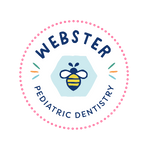Sealants
Some permanent molars have deep grooves and pits where food, plaque and bacteria collect beyond the reach of toothbrush bristles. We may recommend sealants for your child’s healthy, 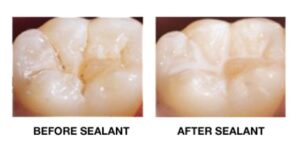 groovy molars; sealants fill in these areas, preventing food and bacteria from sitting there and causing cavities. We seal both first molars (around age 6 – 8 years) and second molars (around 10 – 12 years). At each dental cleaning and exam, we’ll check the integrity of the sealants and touch them up as needed. When placed well, sealants reduce the likelihood of cavities on the chewing surfaces of teeth by 80% during the first two years after placement.
groovy molars; sealants fill in these areas, preventing food and bacteria from sitting there and causing cavities. We seal both first molars (around age 6 – 8 years) and second molars (around 10 – 12 years). At each dental cleaning and exam, we’ll check the integrity of the sealants and touch them up as needed. When placed well, sealants reduce the likelihood of cavities on the chewing surfaces of teeth by 80% during the first two years after placement.
White-Colored Fillings
Small- to moderate-sized cavities can often be treated with white colored fillings called composites. After numbing the tooth, we remove the decayed part of the tooth (cavity) and replace it with the white filling material.
Stainless Steel Crowns
Some teeth have very large cavities with extensive breakdown, or cavities on multiple surfaces. When this happens, we sometimes fix these teeth with a silver crown that covers the entire tooth. 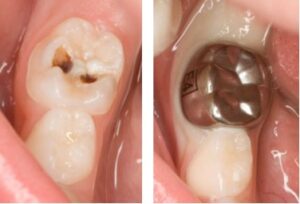 This reinforces the tooth and prevents that tooth from getting another cavity in the future. These teeth will fall out just like other teeth, and you brush and floss them similarly. However, it is important to minimize sticky, chewy foods such as Tootsie Rolls and Laffy Taffy, as these foods can cause the crowns to come off.
This reinforces the tooth and prevents that tooth from getting another cavity in the future. These teeth will fall out just like other teeth, and you brush and floss them similarly. However, it is important to minimize sticky, chewy foods such as Tootsie Rolls and Laffy Taffy, as these foods can cause the crowns to come off.
Pulpotomy
When a cavity on a baby tooth is very close to the nerve (also called pulp) of the tooth, we do a procedure called a pulpotomy. The dentist will remove the infected pulp and the bacteria that caused the cavity, fill the area with a putty-like material, and then cover the tooth with a stainless steel crown.Extraction
Unfortunately, sometimes we are unable to fix a tooth and we have to remove it. We consider the size of the cavity, your child’s pain symptoms, and the time until the tooth falls out. We commonly tell young 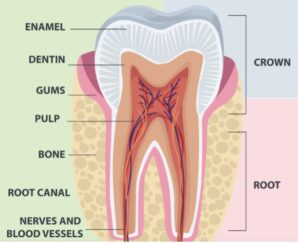 children that we will give their tooth to the Tooth Fairy and ask you to refrain from using words like “pull” and “yank.”
children that we will give their tooth to the Tooth Fairy and ask you to refrain from using words like “pull” and “yank.”
Space Maintainers
When we extract a tooth, there will be an adult tooth that will erupt (or grow) in that space. However, sometimes the adult tooth is not ready to erupt and we must save the space for the tooth to grow. We do so by cementing a custom-made space maintainer in that area. This appliance will remain there until the adult tooth grows in. Just like with stainless steel crowns, it is important to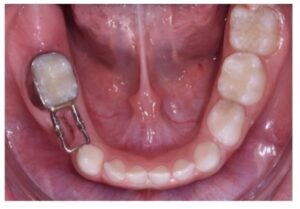 minimize sticky, chewy foods such as Tootsie Rolls and Laffy Taffy, as these foods can cause the appliances to become loose and come off.
minimize sticky, chewy foods such as Tootsie Rolls and Laffy Taffy, as these foods can cause the appliances to become loose and come off.
Local anesthesia (“Novocain”)
Ensuring that your child is absolutely comfortable for his or her dental procedure is a priority. When we need your child’s teeth to be numb, we use a numbing jelly (“warm sleepy jelly”) prior to injecting local anesthetic (“cold sleepy water”). We ask that you refrain from using words like “shot”, “pinch,” “poke” and “needle” as this may unnecessarily scare your child. Depending on which area of the mouth was treated, your child will have numbness for 3 – 5 hours following treatment. Pay close attention to them, as it is very easy for young children to bite or suck on their numb lips and cause injuries, as they do not know how hard they are biting.
Nitrous oxide (“Laughing Gas”)
Some children are anxious about dental treatment or are very young when treatment is needed. In these cases, we may recommend nitrous oxide, or laughing gas, to put your child at ease. Laughing gas also helps children with a very sensitive gag reflex tolerate dental treatment. With laughing gas, children feel a sense of calm and ease, and fingers and toes might feel tingly. They are still awake and can interact with the dental team. A small percentage of children feel nauseous and we then reduce the amount we are using. Laughing gas is very safe and your child will not feel groggy or sedated after his or her appointment. When we turn it off and have your child breath 100% oxygen, the laughing gas is out of their system. Your child can return to school and regular activities that day.
